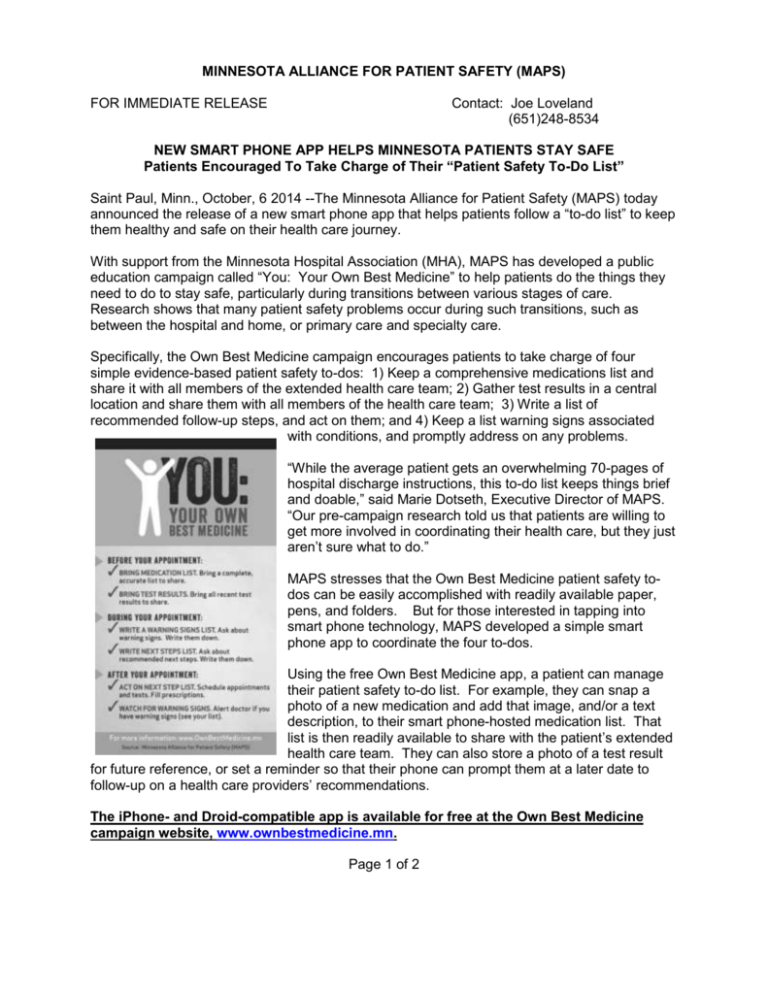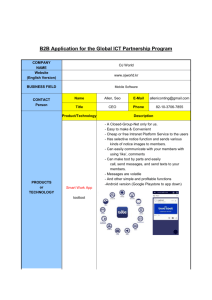MINNESOTA ALLIANCE FOR PATIENT SAFETY (MAPS) FOR
advertisement

MINNESOTA ALLIANCE FOR PATIENT SAFETY (MAPS) FOR IMMEDIATE RELEASE Contact: Joe Loveland (651)248-8534 NEW SMART PHONE APP HELPS MINNESOTA PATIENTS STAY SAFE Patients Encouraged To Take Charge of Their “Patient Safety To-Do List” Saint Paul, Minn., October, 6 2014 --The Minnesota Alliance for Patient Safety (MAPS) today announced the release of a new smart phone app that helps patients follow a “to-do list” to keep them healthy and safe on their health care journey. With support from the Minnesota Hospital Association (MHA), MAPS has developed a public education campaign called “You: Your Own Best Medicine” to help patients do the things they need to do to stay safe, particularly during transitions between various stages of care. Research shows that many patient safety problems occur during such transitions, such as between the hospital and home, or primary care and specialty care. Specifically, the Own Best Medicine campaign encourages patients to take charge of four simple evidence-based patient safety to-dos: 1) Keep a comprehensive medications list and share it with all members of the extended health care team; 2) Gather test results in a central location and share them with all members of the health care team; 3) Write a list of recommended follow-up steps, and act on them; and 4) Keep a list warning signs associated with conditions, and promptly address on any problems. “While the average patient gets an overwhelming 70-pages of hospital discharge instructions, this to-do list keeps things brief and doable,” said Marie Dotseth, Executive Director of MAPS. “Our pre-campaign research told us that patients are willing to get more involved in coordinating their health care, but they just aren’t sure what to do.” MAPS stresses that the Own Best Medicine patient safety todos can be easily accomplished with readily available paper, pens, and folders. But for those interested in tapping into smart phone technology, MAPS developed a simple smart phone app to coordinate the four to-dos. Using the free Own Best Medicine app, a patient can manage their patient safety to-do list. For example, they can snap a photo of a new medication and add that image, and/or a text description, to their smart phone-hosted medication list. That list is then readily available to share with the patient’s extended health care team. They can also store a photo of a test result for future reference, or set a reminder so that their phone can prompt them at a later date to follow-up on a health care providers’ recommendations. The iPhone- and Droid-compatible app is available for free at the Own Best Medicine campaign website, www.ownbestmedicine.mn. Page 1 of 2 “It doesn’t matter if patients prefer to use paper or an app, the important thing is that they take charge of monitoring, documenting, and sharing their health information,” said Dotseth. “This is all about avoiding life-threatening safety problems associated with communications breakdowns.” The to-do list is based on research about patient safety problems studied by a MAPS-convened advisory panel of health care experts, particularly problems that occur between stages of care, such as when a patient switches health care providers or health settings. Research finds that many patient safety problems occur when health care providers have incomplete information about a patient’s history of medications and/or diagnostic test results. Patients sometimes assume that health care providers share all of their information, but all too often that doesn’t happen. For example, a Johns Hopkins Hospital study of referrals by 122 pediatricians in 34 states found that information was sent to the specialist in only 49% of cases. The referring physician received feedback from the specialist only 55% of the time. Therefore, to ensure everyone on the health care team is fully informed, patients need to proactively share their medical history. “Patients shouldn’t assume that today’s doctor knows what last week’s doctors learned about them,” said Dotseth. “Patients need to walk their health care team through their medications, symptoms and test results, because it could very well save their life.” Serious problems also occur when patients don’t do the things their health care providers ask of them. For instance, a study from the Northeastern Ohio Network found that 14% of patients never make recommended appointments with specialists. Another study found that about 31% of prescriptions go unfilled. The phone app helps patients better manage such tasks. “Patients and care givers both have room for improvement,” said Dotseth. “This campaign isn’t about casting blame, it’s about giving patients tools to stay safe.” The Own Best Medicine campaign will be promoted through a series of radio and print advertisements, and via a number of health care providers who have volunteered to distribute paper-based patient safety packets to patients. In coming days, the app will also be formatted to work with tablet computer devices. The Minnesota Alliance for Patient Safety (MAPS) is a statewide patient safety coalition founded in 2000. MAPS members include more than 100 organizations, including health care associations, health care organizations, consumers, employers, health plans and state agencies and boards. END Page 2 of 2




